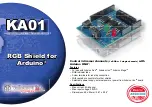
Row
Column-1
Data 0
Data 1
...
Data n
CLK
(EPI0S31)
CKE
(EPI0S30)
CS
(EPI0S29)
WE
(EPI0S28)
RAS
(EPI0S19)
CAS
(EPI0S18)
DQMH, DQML
(EPI0S [17:16])
AD [15:0]
(EPI0S [15:0])
Activate
NOP
NOP
Write
Burst
Term
AD [15:0]drivenout
AD [15:0]drivenout
Host Bus Mode
1236
SPRUHE8E – October 2012 – Revised November 2019
Copyright © 2012–2019, Texas Instruments Incorporated
External Peripheral Interface (EPI)
Figure 17-4. SDRAM Write Cycle
17.7 Host Bus Mode
The host bus supports the traditional 8-bit and 16-bit interfaces popularized by the 8051 devices and
SRAM devices. This interface is asynchronous and uses strobe pins to control activity. Addressable
memory can be doubled using Host Bus-16 mode as it performs half-word accesses. EPI0S0 should be
connected to A0 of 16-bit memories.
17.7.1 Control Pins
The main three strobes are Address Latch Enable (ALE), Write (WR), and Read (RD, sometimes called
OE). Note that the timings are designed for older logic and so are hold-time vs. setup-time specific. The
polarity of the read and write strobes can be active High or active Low by clearing or setting the RDHIGH
and WRHIGH bits in the EPI Host-Bus n Configuration (EPIHBnCFGn) register.
The ALE can be changed to an active-low chip select signal, CS, through the EPIHBnCFGn register. The
ALE is best used for Host-Bus muxed mode in which EPI address and data pins are shared. All Host-Bus
accesses have an address phase followed by a data phase. The ALE indicates to an external latch to
capture the address then hold it until the data phase. The polarity of the ALE can be active High or Low by
clearing or setting the ALEHIGH bit in the EPI Host-Bus n Configuration (EPIHBnCFGn) register. CS is
best used for Host-Bus unmuxed mode in which EPI address and data pins are separate. The CS
indicates when the address and data phases of a read or write access are occurring. Both the ALE and
the CS modes can be enhanced to access four external devices using settings in the EPIHBnCFGn
register. Wait states can be added to the data phase of the access using the WRWS and RDWS bits in
the EPIHBnCFGn register. Additionally, within these wait state options, the WRWSM and RDWSM bit of
the EPIHBnTIMEn register can be set to reduce the given wait states by 1 EPI clock cycle for finer
granularity.
For FIFO mode, the ALE is not used, and two input holds are optionally supported to gate input and output
to what the XFIFO can handle.















































